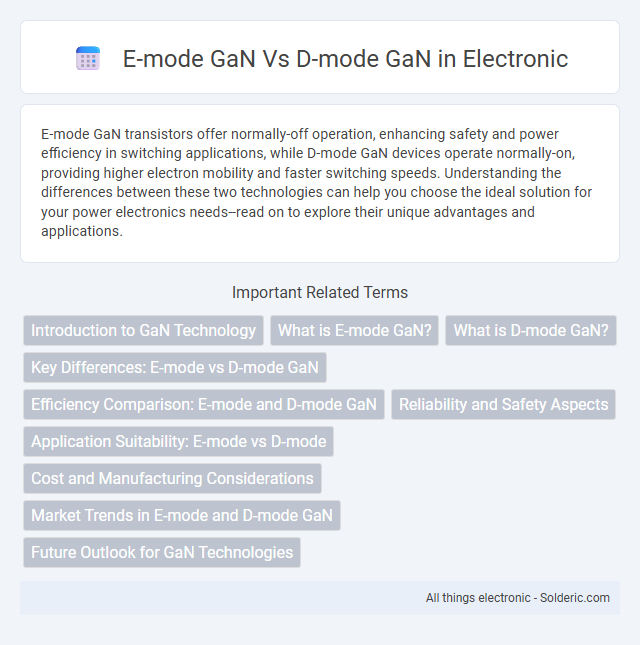E-mode GaN transistors offer normally-off operation, enhancing safety and power efficiency in switching applications, while D-mode GaN devices operate normally-on, providing higher electron mobility and faster switching speeds. Understanding the differences between these two technologies can help you choose the ideal solution for your power electronics needs--read on to explore their unique advantages and applications.
Comparison Table
| Feature | E-mode GaN (Enhancement-mode) | D-mode GaN (Depletion-mode) |
|---|---|---|
| Operation Type | Normally OFF | Normally ON |
| Gate Voltage | Positive Gate Voltage to Turn ON | Zero or Negative Gate Voltage to Turn OFF |
| Application | Power switching, low gate drive complexity | Simple driver design, fail-safe operation |
| Safety | Safer due to default OFF state | Risk of unintended conduction |
| Gate Drive Complexity | Higher gate drive voltage required | Lower gate drive voltage required |
| Switching Speed | High, suitable for high-frequency applications | High, but sometimes limited by default ON state |
| Market Trend | Increasing adoption in power electronics | Established use but gradually replaced by E-mode |
Introduction to GaN Technology
GaN technology features two main transistor types: E-mode (Enhancement-mode) and D-mode (Depletion-mode), each offering unique benefits in power electronics. E-mode GaN transistors are normally off, providing safer and more efficient switching in applications like power supplies and RF amplifiers. D-mode GaN transistors are normally on, often used in circuits requiring fail-safe operation or specific bias conditions, contributing to GaN's overall versatility in high-frequency, high-efficiency environments.
What is E-mode GaN?
E-mode GaN (Enhancement-mode Gallium Nitride) transistors operate with a positive threshold voltage, meaning they remain off at zero gate bias and only conduct when a sufficient gate voltage is applied. This normally-off characteristic makes E-mode GaN devices safer and more efficient for power electronics, as they reduce power losses and enhance system reliability. E-mode GaN is widely used in applications such as power converters, RF amplifiers, and automotive electronics where energy efficiency and compactness are critical.
What is D-mode GaN?
D-mode GaN, or depletion-mode gallium nitride, is a type of transistor that is normally on at zero gate voltage and requires a negative gate voltage to switch off. It is widely used in high-frequency power electronics and radio-frequency amplifiers due to its high electron mobility and efficiency. Unlike E-mode GaN (enhancement-mode), which is normally off and safer for digital circuits, D-mode GaN serves as a key component in analog and RF applications requiring normally-on behavior.
Key Differences: E-mode vs D-mode GaN
E-mode GaN (Enhancement-mode Gallium Nitride) transistors are normally off devices requiring a positive gate voltage to conduct, offering simpler circuitry and improved safety in power electronics. D-mode GaN (Depletion-mode Gallium Nitride) transistors are normally on and need a negative gate voltage to turn off, providing lower conduction losses but more complex gate drive requirements. The choice between E-mode and D-mode GaN significantly impacts system design, efficiency, and control complexity in applications like power converters and RF amplifiers.
Efficiency Comparison: E-mode and D-mode GaN
E-mode GaN transistors offer normally-off operation, enhancing system safety and simplifying circuit design, which can improve overall power efficiency in applications like power converters and RF amplifiers. D-mode GaN devices, while normally-on, typically provide lower conduction losses and higher electron mobility, making them highly efficient for high-frequency and high-power scenarios. Your choice between E-mode and D-mode GaN depends on balancing safety requirements with performance needs to achieve optimal efficiency in your specific application.
Reliability and Safety Aspects
E-mode GaN devices offer enhanced safety due to their normally-off behavior, reducing the risk of unintended conduction and improving system reliability in power electronics. D-mode GaN transistors, being normally-on, require additional circuitry for safe operation, which can introduce complexities and potential failure points. Your choice of E-mode technology ensures more straightforward, fail-safe designs with increased longevity under thermal and electrical stress conditions.
Application Suitability: E-mode vs D-mode
E-mode GaN transistors, known as enhancement-mode devices, are widely preferred for power electronics in applications requiring fail-safe operation and simple gate drive circuits, such as power converters and motor drives. D-mode GaN transistors, or depletion-mode devices, are typically used in amplifier circuits and RF applications where normally-on behavior facilitates linear amplification and low noise performance. The choice between E-mode and D-mode GaN depends on the specific requirements of the application, with E-mode favoring digital switching and safety, while D-mode suits analog amplification and high-frequency RF functions.
Cost and Manufacturing Considerations
E-mode GaN transistors typically incur higher manufacturing costs due to the complexity of achieving a normally-off operation, requiring precise gate engineering and advanced epitaxial growth techniques. In contrast, D-mode GaN devices are generally less expensive to produce as they naturally exhibit normally-on behavior with simpler fabrication processes. The cost difference influences device selection based on application requirements, balancing performance benefits against manufacturing scalability and overall expenses.
Market Trends in E-mode and D-mode GaN
Market trends indicate a growing preference for E-mode GaN transistors in power electronics due to their normally-off characteristics, enhancing safety and simplifying circuit design. While D-mode GaN devices remain valuable for high-frequency and high-power applications, E-mode GaN is rapidly expanding in automotive, industrial, and consumer electronics sectors. Industry forecasts project the E-mode GaN market to achieve higher CAGR compared to D-mode, driven by increasing demand for energy-efficient and compact power systems.
Future Outlook for GaN Technologies
E-mode GaN (Enhancement-mode Gallium Nitride) devices offer inherent safety advantages and simpler circuit designs, making them highly suitable for next-generation power electronics and RF applications. D-mode GaN (Depletion-mode Gallium Nitride) devices continue to deliver superior electron mobility and mature manufacturing processes, ensuring their relevance in high-frequency and high-power scenarios. Your choice between E-mode and D-mode GaN will shape the efficiency, reliability, and scalability of future GaN-based technologies in power conversion and wireless communications.
E-mode GaN vs D-mode GaN Infographic

 solderic.com
solderic.com